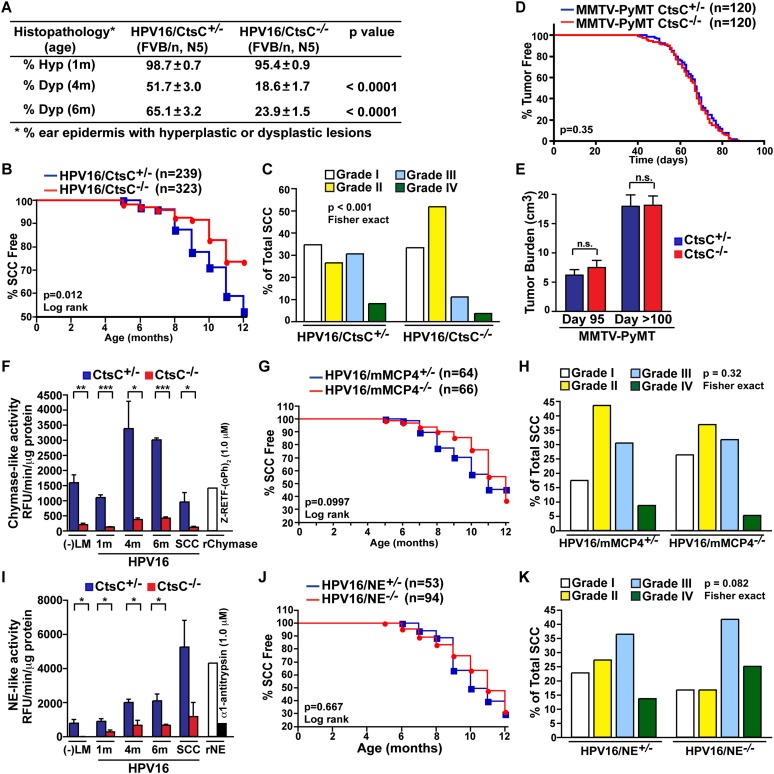Figure 4.
CtsC promotes progression of SCCs but not mammary carcinomas. (A) Percentages of ear skin (area) exhibiting hyperplasia by 1 mo of age (Hyp) or dysplasia by 4 and 6 mo of age (Dys). n = 9–29 mice per category. (B) Percentage of SCC-free in HPV16/CtsC+/− (blue) and HPV16/CtsC−/− (red) cohorts. (C) Grading of SCC tumors from HPV16/CtsC+/− (right) and HPV16/CtsC−/− (left) mice. n = 239 mice (HPV16/CtsC+/− cohorts); n = 323 mice (HPV16/CtsC−/− cohorts). (D) Mammary tumor incidence for MMTV-PyMT/CtsC+/− (blue) and MMTV-PyMT/CtsC−/− (red) animals shown by the percentage of mice without visible tumors. n = 120 mice per group. (E) Total tumor burden for mice at day 95 and at end stage (day >100). n = 18–23 mice per group. (F) Enzyme activity of chymase was assessed in skin ear tissue lysates from negative littermates (−LM), HPV16/CtsC+/− (blue) and HPV16/CtsC−/− (red) cohorts at 1, 4, and 6 mo of age; and SCC tumor tissue. n = 3–4 mice per group, with each sample assayed in triplicate. Significance was determined by an unpaired t-test; (*) P < 0.05; (**) P < 0.01; (***) P < 0.001. (G,H) Percentage of SCC-free (G) and SCC tumor grading (H) in HPV16/mMCP4−/− cohorts (red) compared with HPV16/mMCP4+/− control cohorts (blue). n = 64 mice (HPV16/mMCP4+/− cohorts); n = 66 mice (HPV16/mMCP4−/− cohorts). (I) Enzyme activity of NE was assessed in skin ear tissue lysates from negative littermates (−LM); HPV16/CtsC+/− (blue) and HPV16/CtsC−/− (red) cohorts at 1, 4, and 6 mo of age; and SCC tumor tissue. n = 3 mice per group, with each sample assayed in triplicate. Significance was determined by an unpaired t-test; (*) P < 0.05. (J,K) Percentage of SCC-free (J) and SCC tumor grading (K) in HPV16/NE−/− cohorts (red) compared with HPV16/NE+/− control cohorts (blue). n = 53 mice (HPV16/NE+/− cohorts); n = 94 mice (HPV16/NE−/− cohorts).

